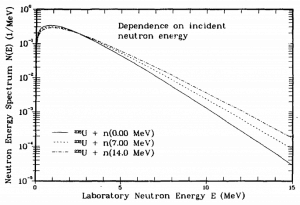Prompt Neutron Energy Spectrum
Studying prompt neutron energy spectra is important in many nuclear reactor applications (e.g.,, criticality calculations) and constitutes the most important component of the source term for nuclear reactor shielding calculations.
Basic features of prompt neutron energy spectra are summarized below:
- The neutrons produced by fission are high-energy neutrons.
- Almost all fission neutrons have energies between 0.1 MeV and 10 MeV.
- The prompt neutron energy distribution, or spectrum, maybe best described by the dependence of the fraction of neutrons per MeV on neutron energy.
- The most probable neutron energy is about 0.7 MeV. The mean neutron energy is about 2 MeV.
- These values are for thermal fission of 235U, but these values vary only slightly for other nuclides.
Prompt neutron fission spectra evaluation is one of the most interesting aspects of the evaluation of actinides. Many experimental and theoretical researches have been carried out for the determination of prompt neutron spectra. There are several representations of prompt fission neutron spectra. The Maxwellian and Watt spectrum are two early models of the prompt fission neutron spectrum, which are still used today.
The modern spectrum representation of the prompt fission neutron spectrum and average prompt neutron multiplicity is called the Madland-Nix Spectrum (Los Alamos Model). This model is based upon the standard nuclear evaporation theory and utilizes an isospin-dependent optical potential for the inverse process of compound nucleus formation in neutron-rich fission fragments.

Source: Madland, David G., New Fission-Neutron-Spectrum Representation for ENDF, LA-9285-MS, April 1982. http://www.iaea.org/inis/collection/NCLCollectionStore/_Public/14/718/14718824.pdf

Source: Madland, David G., New Fission-Neutron-Spectrum Representation for ENDF, LA-9285-MS, April 1982. http://www.iaea.org/inis/collection/NCLCollectionStore/_Public/14/718/14718824.pdf